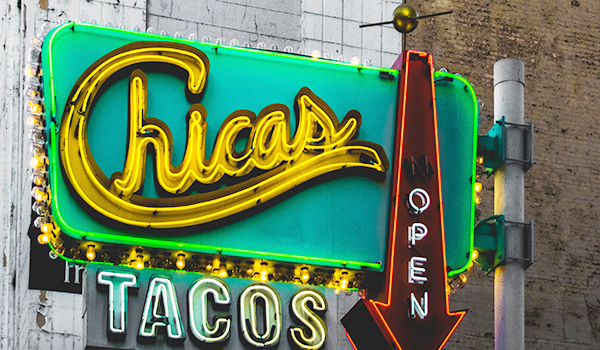What’s in a restaurant’s name? Everything. A single word or phrase can bring to life the smells, tastes, and ambiance of a particular place. So you’ll want to put a lot of thought into what you name your restaurant.
In this section, we’ll suggest ways to get your creative juices flowing. You’ll walk away from this section knowing:
- Brainstorming methods to lead you in the right direction
- What not to do when naming your restaurant
- How to check that your restaurant name is not already taken
- Some examples of restaurants who got their name right
Restaurant Name Brainstorming Methods
As with all creative tasks, a brainstorm is the best way to get the creative juices flowing. But there are several ways you can structure a brainstorm to get the most out of it, so you don’t end up following the “wrong” path.
Generations of artists and creatives have developed ways to effectively brainstorm so that you’re able to think big, but focus your thoughts when you feel you’re on the right track.
Here are a few brainstorming methods to get you started.

1. The Word Storm
Word storming is simple.
Write down a single word on a piece of paper.
Write down the next word that comes to mind when you read that word.
Here’s what it looks like:
- Cajun [leads to]
- Louisiana [leads to]
- New Orleans [leads to]
- Restaurant [leads to]
- Grill [leads to]
- Kitchen [leads to]
- Blackened [leads to]
- Blackened chicken [leads to]
- Jambalaya [leads to]
- Crawfish [leads to]
- Bourbon street rigatoni [leads to]
- Bourbon Street [leads to]
- Mardis Gras [leads to]
- Carnival [leads to]
- Wild [leads to]
- Party [leads to]
- Music [leads to]
- Balfa Brothers
After your initial word storm, group the words you have into various combinations that could form a restaurant name.
For example:
- Blackened Bourbon Street Grill
- Wild Louisiana Kitchen
- Cajun Crawfish Carnival Kitchen
If you get stuck, here’s an online word storm tool to help you out.
2. Mindmapping
A mind map is a visual representation of your brainstorm. Think of tree branches connected by a central word. If you’re a visual learner, this technique may be for you.
Here’s how to create a mind map:
- Write down a word.
- Create a branch off of that word and link it to another word.
- Repeat the process, creating more branches as you continue to think of associated words.
For example:
Again, taking the word “cajun”, we created a map similar to our earlier word storm. You can add to your map by creating another tree for a concept like “fast casual” or a flavour like “spicy”.
You can do this the old-fashioned way on a piece of paper, or you can use an online tool like Google Chrome’s Coggle.it.
Review Your Concept and Goals
Creative ideation aside, your restaurant name always needs to reflect your concept in some way or another. So after you’ve done some brainstorming, make sure to go back and review your goals as a business. Your restaurant’s name should be inspired by your restaurant’s mission.
For example:
- Restaurant name: Bliss Raw Cafe and Elixir Bar
- Mission statement: Eat clean. Eat raw. Live well.
Analysis: The idea of “living well” is captured by the word “bliss”. Their mission to provide clean and raw food is also present in their title.
Creative Prompts
After you’ve done a “blue sky” brainstorming session, you’ll also want to consider other prompts. Prompts are straightforward facts about your restaurant or your life that may inspire additional words that could fit with your concept.
Here are some common prompts to examine during your ideation process.
Location
A restaurant name based on location can sometimes allow you to stake your flag in the ground and claim some ownership – figuratively – over the neighbourhood, you occupy.
More importantly, however, a location-based restaurant name is a dream situation for search engine optimisation: when a hungry diner searches for your cuisine type + location, they’ll be more likely to stumble upon your establishment.
Take Vancouver’s Kits Sushi. A hungry diner might think: I want sushi. I’m in Kitsilano. They might Google: sushi in Kitsilano. Kits Sushi will likely be at the top of the list.
Concept
When you include your restaurant concept in your name, you attract customers craving a specific type of food or ambiance. If you were to read “Paddy Long’s Beer & Bacon Pub,” you know what to expect: an Irish pub, cold beer, a mean St. Patrick’s day party, and, in this case, lots of bacon.
Your own name
Using your first or last name adds a personal touch to your restaurant’s name. Only use your name if it matches the tone of your restaurant.
For example, doesn’t Mumma Martino’s scream homemade pasta? It works because the restaurant is a family-style Italian restaurant. It would not work if Mumma Martino’s was a swanky cocktail bar.
Obscure reference
When you use a literary or pop culture reference in your name, you call out to your target market. Your reference attracts diners with a mutual interest.
For example:
- NYC’s Gotham City Lounge
- Toronto’s Hemingway’s
- San Antonio’s Wok This Way
- Australia’s Lord of the Fries
Your mission, differentiator, or niche
If your mission resonates with a specific niche, including it in your name will attract that target market. Take Chicago’s The Loving Heart Vegan Cafe, for example. From their name alone, diners understand that saving animals is an important part of their mission. If that mission means something to diners, they’re more likely to give the restaurant a try.
Cuisine type
Indian, Thai, German, or Ethiopian: using cuisine type in your name tells diners what they can expect. When diners choose a restaurant based on a craving, this naming style is the best one to attract them.
Speciality dish
If you’ve built your restaurant based on a specific dish, you can emphasise it in your restaurant’s name. Speciality dish names apply especially to restaurants that offer burgers, fish and chips, sushi, poke, or tacos.
Rhetorical devices
Rhetorical devices have the power to make your restaurant’s name stick out in the minds of consumers. Here are few types of wordplay you can use:
Alliteration
Alliteration is “the occurrence of the same letter or sound at the beginning of closely connected words.” The cadence of alliteration captures people’s attention and makes your name easy to remember. For example: Krispy Kreme Donuts.
Puns
Puns are “a joke exploiting the different possible meanings of a word.” Using a pun in your restaurant name gets diners laughing and their brains working. For example: Pho King Fabulous is a Vietnamese pho restaurant.
What Not to Do when Naming Your Restaurant
Just as there are best practices in naming your restaurant, there are also things you should absolutely avoid. As you’re brainstorming names, make sure to go through this list to prevent committing these missteps before your name is set in stone.
Don’t use a name that’s trademarked or copyrighted
Before you engrave your pens or buy your domain name, make sure there are no other restaurants using your name. To do this, refer to your national trademark database. You can perform a search on these federal sites:
US Patent and Trademark Office
Government of Canada Trademarks
Don’t use a name that’s similar to your competitors
“Did I go to Fresh? Or was it Freshii?”
Being memorable starts with being unique. The last thing you want is to mess with word of mouth by causing future patrons to refer a friend to a competitor instead of your restaurant. Make sure your name is as different from local competitors as possible.
Don’t use a name that’s too obscure
While you want to stand out, there’s a caveat: your name should still roll off the tongue.
Unpronounceable names can deter guests or make it difficult for guests to relay their experience to friends after a visit. Names that are too complex or long have the same effect. Many restaurants choose one-word names because they’re easy to remember.
Don’t use a name based on something that’s temporary
You could name your restaurant after your head chef or your street address, but what if your chef leaves or your location changes? Make sure you choose a name that’s going to apply for the long term.
Don’t choose a name without third-party input
Run your creative restaurant names by trusted advisors, friends, and a sample of your target market. If the name doesn’t appeal to your target market, you risk losing out on diners before they walk in the door.
Catchy restaurant names
Clever restaurant names
Creative and unique restaurant names
- Where the Buffalo Roam
- Tequila Bookworm
- The Black Ant
- Ninja New York
- Dirt Candy
- Mustard’s Last Stand
- The Only Cafe
- The One that Got Away
Choosing your restaurant’s name is no small feat. It has to be catchy, clever, creative, and unique, all while capturing the essence of your restaurant. It’s a tall order. But by using the prompts and strategies in this section, you’ll be perfectly positioned to create a name that will be with you for the long run.
